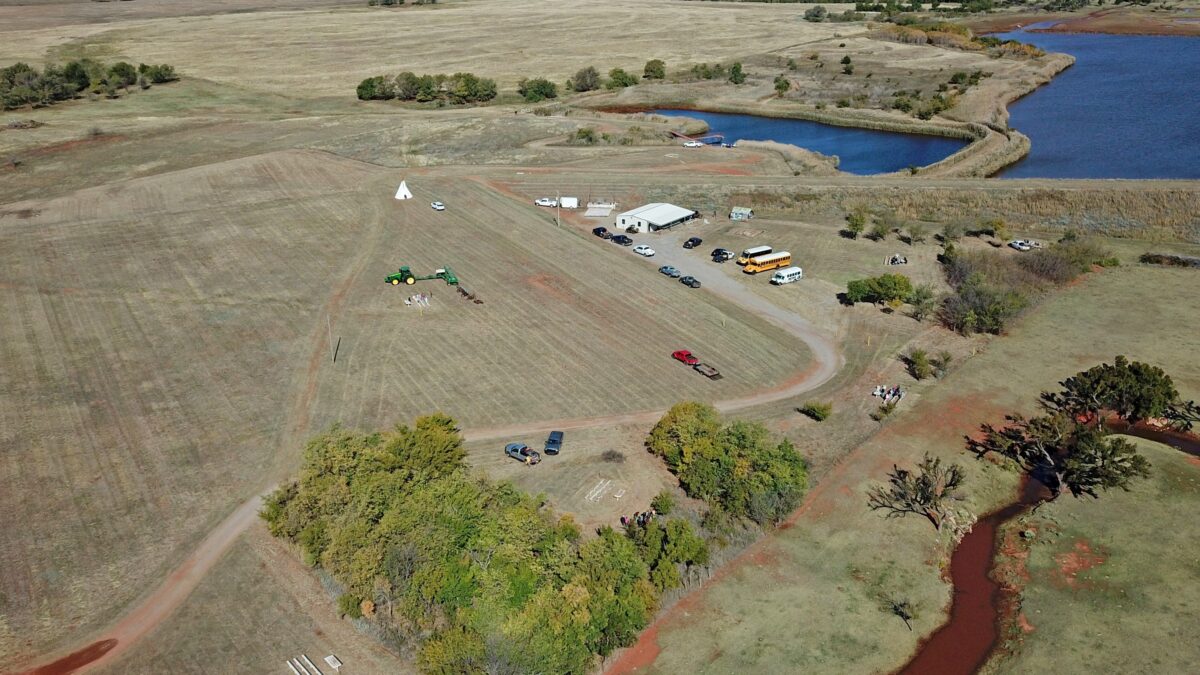Rye Cover Crop Keeps Moisture on Drought-Prone Oklahoma Farm
AFBF Staff

People didn’t use the term “cover crop” 50 years ago, but the Smiths were growing one on their farm in western Oklahoma.
Like his father and grandfather before him, Jimmy Smith grows rye as a companion to cotton. What some would call an innovation has long been considered a necessity where the Smiths farm. The year-round presence of a living root retains precious moisture in a drought-prone region and prevents wind erosion of sandy soils.
Farm Bureau members Jimmy and Cathy Smith farm with their children, Spencer and Calli. They credit conservation practices and technological advances with saving time and money, and benefiting the landscape.
The Smith family’s efforts earned them the 2022 Oklahoma Leopold Conservation Award®.
Cover Crop Provides Measurable Soil Improvement
Growing rye as a cover crop has improved the Smith’s soil, which averages 2 to 4% organic matter compared to the statewide .5% average. They began inter-seeding rye on their fields prior to harvesting cotton in 1998. There was a time when they used a moldboard plow to integrate rye back into the soil each spring. They now terminate the cover crop with herbicides rather than tilling it. Jimmy had completed a transition from conventional tillage to strip tillage to no-till practices across his 2,200 acres of cotton by 2010.
Smith Family Farm also grows an additional 200 acres of rye, some of which is used to graze their herd of 40 beef cattle. The rest produces the seed used to plant that year’s cover crop. Rye grows on the farm’s sandiest soils, which cannot produce cotton.
Benefits Beyond Soil Quality
To improve water quality in the Elk City Lake watershed, the Smiths utilize nutrient management plans and have fenced off riparian areas from cattle with assistance from USDA’s Natural Resources Conservation Services. They also retrofitted watering facilities for wildlife, resulting in an uptick of local turkey and deer populations.
Much of Smith Family Farm borders residential areas of Elk City. The Smiths maintain neighborly relations using precision application technology that reduces drift of fertilizers and pesticides.
They have a positive impact off the farm as well.
Smith Family Farm became a cooperator with the North Fork of the Red River Conservation District in 1988, and Jimmy has served on its board since 2001. Spencer serves on USDA’s Farm Service Agency Committee for Beckham County. Smith Family Farms hosts field days to show fellow farmers, researchers and agribusiness professionals their conservation practices.
Jimmy and Spencer’s ingenuity led to the creation of an agriculture manufacturing business. When the Smiths switched to no-till practices, they noticed their planter gauge wheels quickly wore out. After working with a machinist to build stronger tires, other farmers took notice. The Smiths partnered with machinist Jake Hunter to launch 4 AG MFG, which now produces and sells wheels for no-till planters and air seeders internationally.
It's the latest reinvention in a story that began when Jimmy’s great-grandparents Edmond and Martha purchased the farm’s original 300 acres in 1913 to grow cotton and raise cattle. Smith Family Farms survived the Great Depression and the Dust Bowl and witnessed nearby Elk City’s run as a booming cotton town from the 1930s to the 1970s, with nine cotton gins in operation.
When Jimmy returned home from college to farm with his father and grandfather, “soil health” wasn’t a commonly used term. Yet his efforts to improve the soil, water and wildlife in his care ever since earned him an induction into the Oklahoma Conservation Hall of Fame in 2021.
Leopold Conservation Award
Given in honor of renowned conservationist Aldo Leopold, Sand County Foundation and national sponsor American Farmland Trust present the Leopold Conservation Award to farmers, ranchers and forestland owners in 27 states for land, water and wildlife habitat management.
In 2021, Oklahoma farmers, ranchers and forestland owners were encouraged to apply (or be nominated) for the award. Applications were reviewed by an independent panel of agricultural and conservation leaders.
In Oklahoma, the $10,000 award is presented annually by Sand County Foundation, American Farmland Trust, Oklahoma Farm Bureau Foundation for Agriculture, Oklahoma Cattlemen’s Association, Noble Research Institute, ITC Great Plains, Oklahoma Conservation Commission and USDA’s Natural Resources Conservation Service.